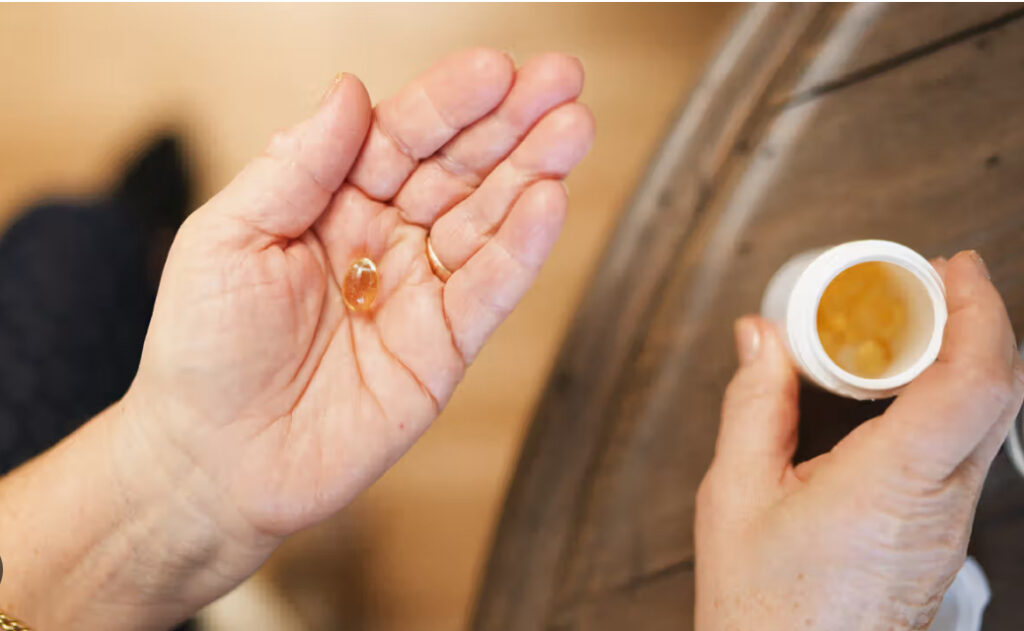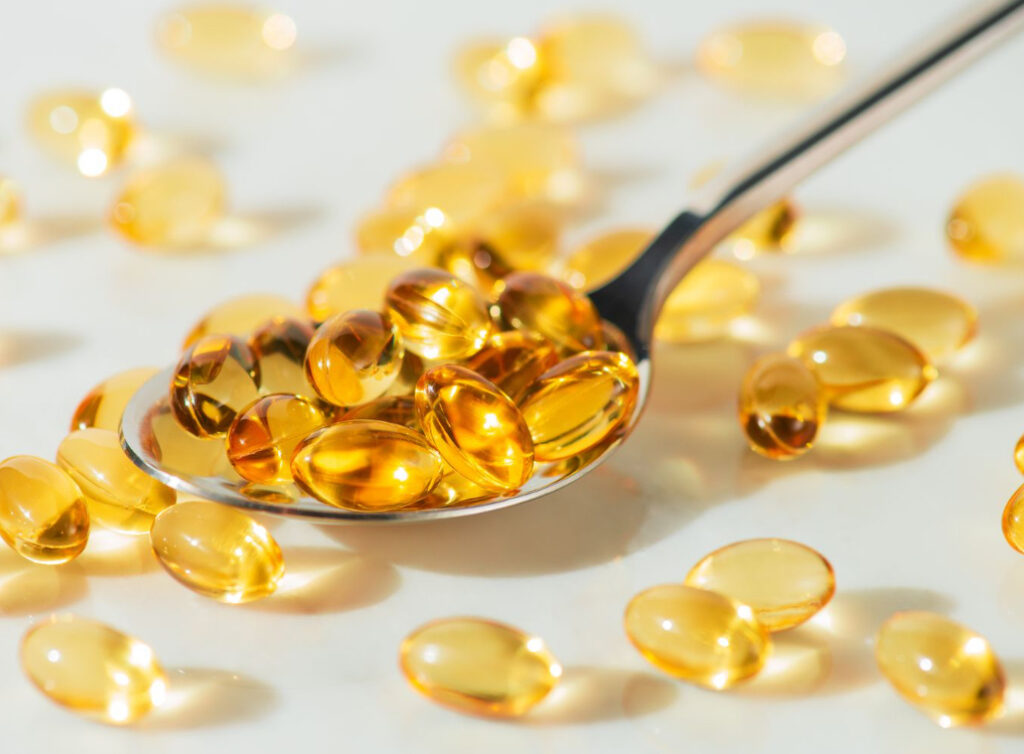Oh winter, it’s that time of year— when the sun disappears by 4 PM, you start questioning your life choices after the third cup of coffee, and your mood is as dark as the sky outside. If winter has you feeling more sluggish than a hibernating bear, you might not just be ‘seasonally over it’—your body could be begging for vitamin D. As winter sets in, shorter days and less sunlight can take a toll on our health in ways we might not immediately notice.
Since our primary source of vitamin D comes from the sun, it’s no surprise that many people experience a drop in their levels during the winter. As Functional medicine practitioners, we see this pattern often in our clinic. (If you happen to be reading this in the summer months, check out our blog for more information on just how important sunshine is—not only for vitamin D levels but also for hormone health.)
But how do you actually know if your vitamin D tank is running on empty? And do you just have to grin and bear it outside in the freezing temperatures to get a little sun? Let’s dive into all of it from a functional medicine perspective in this blog: the common (& uncommon) signs of vitamin D deficiency, why Vitamin D likes to be partnered up with Vitamin K2, the best food sources for vitamin D, and a few tips on how to choose a quality supplement if you choose to go that route.
1. Common (& Uncommon) Signs of Vitamin D Deficiency: What We Look for in our Functional Medicine Clinic

Vitamin D wears many hats when it comes to maintaining good health—supporting your immune system, keeping your bones strong, and more. (You thought that was calcium’s job, right? Surprise! Vitamin D is an unsung hero of bone health.) However, when your Vitamin D levels drop too low, you might experience some common symptoms of deficiency:
-Fatigue and overall low energy: Maybe this comes in the form of persistent tiredness, even if you got a full night’s sleep and a cup of coffee in the morning.
-Frequent illness: Since this vitamin plays such a role in your immune system, low levels might leave you more susceptible to colds, flus, or infections.
-Muscle weakness & joint pain: Vitamin D works synergistically with calcium to help your body efficiently use/absorb the calcium which supports your overall muscle and joint health. A deficiency may lead to aches, stiffness, and, in some cases, even an increased risk of fractures. (More specific info on nutrition for healthy joints HERE)
-Mood changes & seasonal depression: Low vitamin D levels are linked to mood disorders, including depression and seasonal affective disorder (SAD).
-Slow Wound Healing: If cuts and bruises take longer than usual to heal, a deficiency might be impairing your immune response.
-Hair Loss: While multiple factors contribute to hair loss, some studies suggest a connection between low vitamin D and thinning hair.
Here are some lesser common signs that you might be experiencing a deficiency:
-Sweating (Especially on the Head and Neck):
Excessive sweating, particularly on the forehead or scalp, can be an early but overlooked symptom of low levels. This is sometimes seen in newborns and adults with deficiencies.
-Dizziness and Balance Issues:
This vitamin plays a role in muscle function and neurological health. A deficiency can contribute to vertigo, dizziness, and poor balance, increasing the risk of falls.
-Gum Disease and Bleeding Gums:
A deficiency can weaken the immune system, making the gums more susceptible to infections, inflammation, and bleeding—similar to vitamin C deficiency symptoms.
-Sensitivity to Pain:
Low vitamin D levels are associated with an increased pain sensitivity, particularly in conditions like fibromyalgia. This can manifest as chronic body aches, nerve pain, or heightened response to minor injuries.
2. Tip from your Functional Medicine Practitioner: Take These Vitamins Together

Many people supplement with vitamin D3, but fewer are aware of the crucial role vitamin K2 plays alongside it. Here’s why they work best together:
-Calcium Regulation: Vitamin D helps your body absorb calcium, but without K2, that calcium may be deposited in arteries instead of bones. K2 directs calcium to where it’s needed—bones and teeth—reducing the risk of arterial calcification.
-Heart and Bone Health: Research suggests that taking vitamin D without K2 may contribute to calcium buildup in blood vessels, increasing the risk of cardiovascular issues.
To get the most out of your supplement, look for one that combines vitamin D3 with K2 (MK-7 form), which has a longer half-life in the body and is more bioavailable. At our functional medicine clinic, we offer this exact supplement- click HERE to purchase).
3. Foods Rich in Vitamin D

While sunlight is the most effective way to boost vitamin D levels, certain foods can help, especially in the winter months (but we would encourage these through the year as well):
– Fatty fish (salmon, mackerel, sardines, and tuna)
– Egg yolks
– Beef liver
– Mushrooms (especially those exposed to UV light)
Despite these dietary sources, it’s often difficult to get enough of this vitamin through food alone, which is why supplementation is commonly recommended, particularly in the winter.
4. Focus on Quality Supplements

Not all supplements are created equal. Here’s what to look for when choosing a high-quality option:
– Vitamin D3 (cholecalciferol) over D2 – D3 is the active form that your body naturally produces from sunlight and is better absorbed than D2.
– Paired with K2 (MK-7 form) – This ensures proper calcium distribution.
– Oil-based or emulsified formulas – Since vitamin D is fat-soluble, it absorbs best when taken with fat. Some high-quality supplements come in oil-based forms (like MCT oil) for better bioavailability.
– Third-party tested – Ensures purity, potency, and lack of contaminants.
5. Absorption and Gut Health (another key factor in a Functional Medicine approach)

Even if you’re taking the right supplement, poor absorption can still lead to deficiency. Gut health plays a huge role in how well your body absorbs fat-soluble vitamins like D. If you have digestive issues (such as IBS, Crohn’s, or leaky gut), your body may struggle to absorb enough vitamin D from food or supplements. Since gut health impacts so many bodily processes, optimizing digestion is key to better vitamin D absorption.
To enhance absorption:
– Take your vitamin D with a meal that contains healthy fats (avocados, nuts, or olive oil).
– Support gut health with probiotics and digestive enzymes.
– If you have underlying gut conditions, consider coming into our clinic in Onalaska for a functional medicine consultation to see if you might have malabsorption issues.
If you really want to dive into more about vitamin D’s role in gut health and even chronic disease, check out THIS ARTICLE from the Institute of Functional Medicine.
You Got This!
If you’ve been feeling like a sluggish, achy, slightly moodier version of yourself lately, don’t just blame it on winter blues—your body might be screaming for vitamin D. And trust us, ignoring it won’t make it go away (kind of like those unread emails piling up in your inbox). A few small changes now can make a world of difference in how you feel.
Alright, let’s do a final winter survival checklist:
✅ Get some sunlight (unfortunately, staring longingly out the window won’t do).
✅ Add some vitamin D-rich foods to your meals.
✅ Take a high-quality vitamin D3 + K2 supplement. (Get it HERE)
✅ Support your gut health for better absorption.
✅ Avoid turning into a tired, cranky, permanently bundled-up version of yourself.
Easy, right?😜 Now go forth and conquer winter like the well-nourished, vitamin D-optimized human you were meant to be!
If you still have questions, we would be happy to answer them here at Mitchell Holistic Health in Onalaska, WI.
FAQ: All Your Questions, Answered from a Functional Medicine Perspective
1. Are there other ways to know if I’m deficient?
The best way to know for sure is through a blood test measuring your serum 25-hydroxyvitamin D levels. However, common signs include fatigue, mood swings, muscle weakness, frequent colds, and bone/joint pain—especially in the winter months.
2. How much vitamin D do I actually need?
It depends! The Recommended Daily Allowance (RDA) for adults is around 600–800 IU, but many experts suggest 2,000–5,000 IU daily for optimal levels, especially in winter. Always consult your health care professional for personalized recommendations.
3. What’s the best time of day to take vitamin D?
Since vitamin D is fat-soluble, it’s best taken with a meal that contains healthy fats (like avocado, nuts, or olive oil) to improve absorption. Timing-wise, many prefer taking it in the morning to avoid potential sleep disruptions.
4. Can too much vitamin D be harmful?
Yes, excessive amounts of this vitamin can lead to toxicity (hypercalcemia), causing kidney damage, nausea, and high blood calcium levels. However, toxicity is rare and usually occurs from megadosing supplements (50,000 IU+ daily over time).
5. How long does it take to correct a deficiency?
It depends on how low your levels are. With consistent supplementation and sun exposure, most people see improvements in 4–12 weeks, but severe deficiencies may take longer.
6. Can I get vitamin D from sitting by a sunny window?
Unfortunately, no. Glass blocks UVB rays, meaning you won’t produce vitamin D just by sitting inside near a window. You need direct outdoor sun exposure for your skin to synthesize it naturally.

